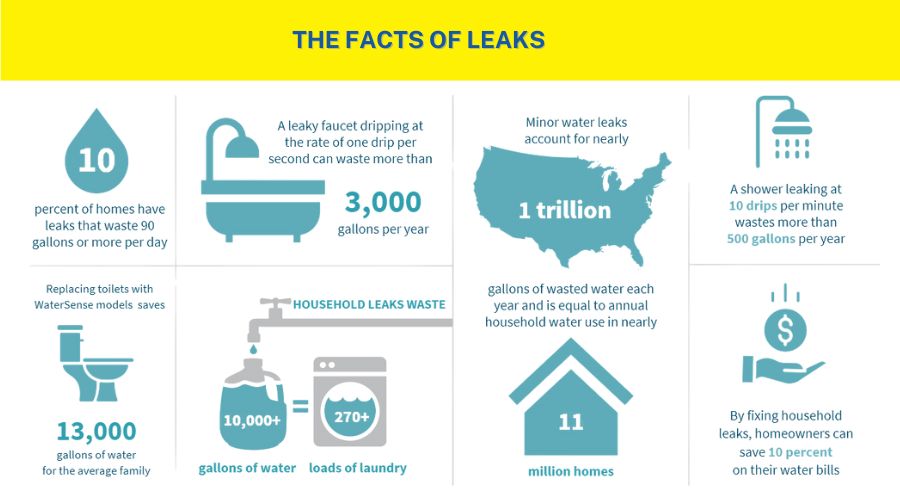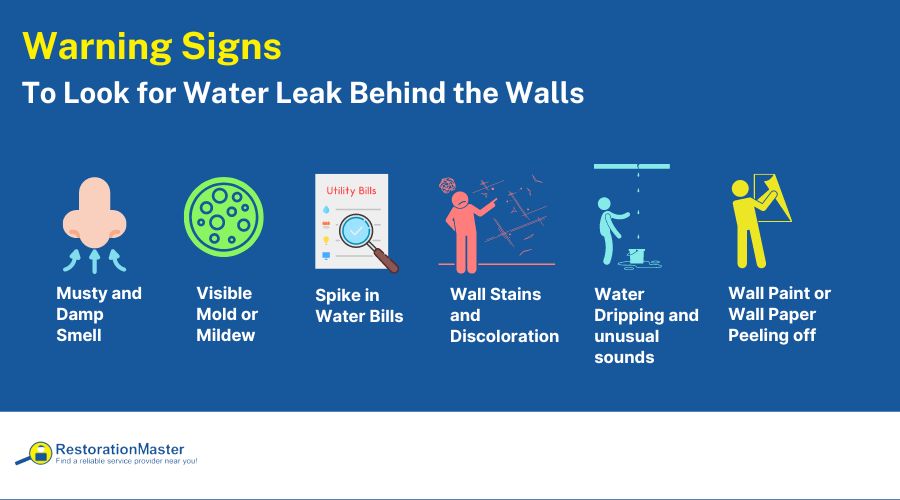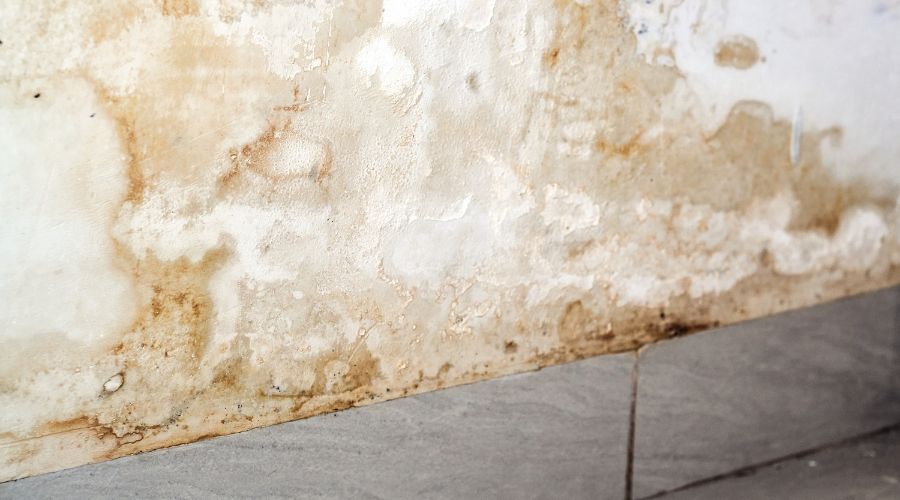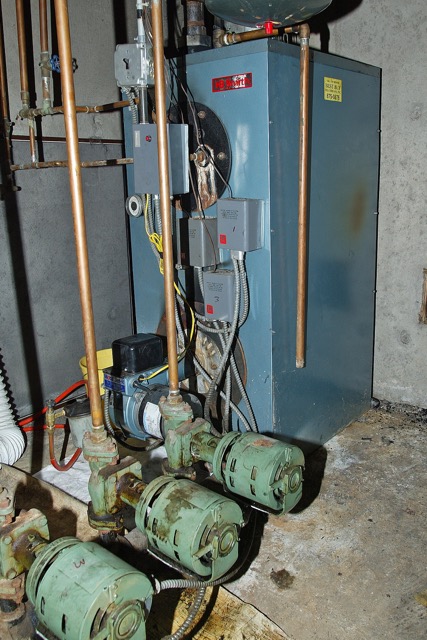Common Signs of a Water Leak You Should Know
There are many potential causes of water damage in your home. Some sources of water damage, such as floods, burst pipes, and sewage backups, are obvious and homeowners notice them right away. However, there are some sources of water damage that are much more difficult to detect such as water leaks behind walls. Homeowners typically do not notice hidden leaks until they have already caused a considerable amount of damage.

Why are Hidden Water Leaks Dangerous?
Hidden water leaks are dangerous because they can cause serious issues like structural damage and mold growth before they are discovered. Excess water and moisture gets absorbed in wood, drywall, insulationInsulation is a material used in buildings to reduce the tra... More, and wallpaper which can leadLead is a heavy metal that can be toxic to humans, especiall... More to warpingWarping is the bending, twisting, or distortion of materials... More, stains, bubbling, and deterioration. Hidden water leaks can also cause moldMold is a type of fungus that grows in damp or humid conditi... More to grow and spread in areas behind walls and ceilings where it is not easily detected. If moldMold is a type of fungus that grows in damp or humid conditi... More in hidden areas is not found and addressed, it can cause extensive damage as well as health issues like allergies and infectionInfection is the invasion and multiplication of harmful micr... More in those who are exposed.
Addressing Water Leaks
Regardless of the source, it is crucial to react to water damage immediately. The damage caused by excess water or moisture will continue to spread and get worse until the source of the water is repaired and the affected materials are dried and restored. Hidden water leaks behind walls can be especially dangerous because the water will get absorbed into flooring, drywall, and ceilings, as well as wooden support beams and sheetrock. If given enough time, a slow leak can result in very serious structural damage that will make the restorationRestoration is the process of returning a property to its pr... More process longer and more expensive.

What are the Signs of a Water Leak Behind Walls?
While water leaks behind walls happen out of view, there are often several signs that can help you detect these water leaks. The following are common signs of water leakage behind your walls.
- Musty odors
- Visible moldMold is a type of fungus that grows in damp or humid conditi... More growth on walls and baseboards
- Staining
- Spike in water bills
- Unusual water dripping sounds
- Peeling or bubbling paint and wallpaper
- Warped walls
- Buckled ceilings and floors
Musty Odors
Excess water or moisture can create a musty smell when it gets absorbed into building materials like sheetrock, wood or drywall. Wall cavities affected by water damage are vulnerable to moldMold is a type of fungus that grows in damp or humid conditi... More growth which also has a pungent musty odorAn odor is a smell, often detectable by the human nose, whic... More. If there is a strong musty smell near a certain area of your wall, there could be a water leak or moldMold is a type of fungus that grows in damp or humid conditi... More growth behind it.
Mold on Walls and Baseboards
MoldMold is a type of fungus that grows in damp or humid conditi... More growth normally appears in areas with excess moisture such as bathrooms, kitchens, and basements. If moldMold is a type of fungus that grows in damp or humid conditi... More appears on your walls, ceilings, or baseboards, especially in an area that is not near any plumbing fixtures, it is very likely that there is a source of moisture behind the walls.
Visible Stains

Water from a leak within the walls will get absorbed in the drywall and sheetrock which will cause a noticeable stain. If the stains on your wall continue to get bigger, this is usually a good indication that there is a hidden plumbing leak.
Paint or Wallpaper Peeling
Too much moisture behind the walls can eventually cause paint and wallpaper to start peeling or bubbling. This normally happens when the sheetrock behind the wall has absorbed too much water. Check for separation in the wallpaper along the seams or flaking paint to help locate a hidden water leak.
Warping Walls
When the sheetrock behind a wall absorbs too much water, it will bend and curve which causes the wall to warp. Excessive warpingWarping is the bending, twisting, or distortion of materials... More can leadLead is a heavy metal that can be toxic to humans, especiall... More to structural damage which is very expensive to repairRepair is the act of fixing or restoring damaged property, m... More. If there is warpingWarping is the bending, twisting, or distortion of materials... More on your walls, this is a clear indication of a water leak.
Water Dripping Sounds
Hearing water dripping when no taps are on is a clear sign of a hidden leak behind your walls. This constant dripping noise often means there’s a steady leak from pipes or fixtures within the wall. Such leaks can cause significant damage over time, leading to moldMold is a type of fungus that grows in damp or humid conditi... More growth and structural issues. If you hear unexplained dripping sounds, investigate the source and call a professional plumber to fix the leak before it causes more damage.
Spike in Water Bills

If you notice a significant increase in your utility bills without a corresponding increase in water usage, it’s a strong indicator that water may be leaking somewhere within your home. It is better to get the leak fixed or it will cost you a lot and hurt your financial situation.
Stained or Buckled Ceilings and Floors
If the sheetrock has absorbed too much water or moisture, it can affect the connected ceilings and floors. Check your floors and ceilings for signs of stains and buckling and if you notice a problem, check the nearby walls for signs of water damage.
How to Test For Hidden Water Leaks?
The signs discussed above are normally indicative of a hidden water leak, but it can be difficult to know for sure if you have a hidden leak from these signs alone. If you find some of the signs of a hidden leak in your home and you want to know for sure, follow these tips to test for a hidden water leak by using your water meter.
- Turn off all faucets in your home as well as appliances that use water.
- Check the water meter and record the usage number.
- Leave the water off for approximately 3 hours inside and outside the home.
- Look at the water meter again to see the usage numbers.
- If the water usage has gone up, then there is a hidden water leak.
What to Do When You Find a Water Leak?

A water leak behind a wall is an issue that requires immediate attention, and it is usually better left to professionals. Addressing a hidden water leak yourself involves removing the wet drywall or sheetrock and either dryingDrying is the process of removing moisture from materials, s... More out the affected materials, or replacing them. You also must find and fix the source of the water which may be difficult to do. By contacting a water damage restoration professional, you can trust that the job will be done effectively and that the technicians will handle all necessary repairs as well as moldMold is a type of fungus that grows in damp or humid conditi... More removal if necessary. Make sure to check your home regularly for signs of a hidden water leak so you can react before it causes serious damage.












